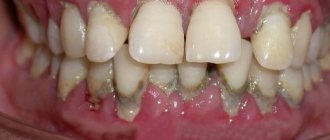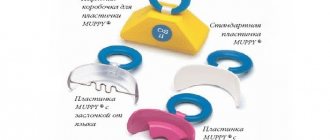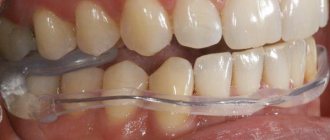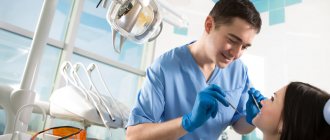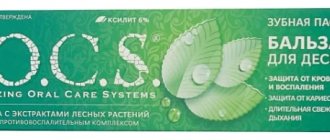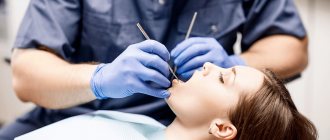From this article you will learn:
- What does Lincomycin help with?
- Lincomycin capsules – price 2022,
- how to use Lincomycin in dentistry and for the treatment of purulent-inflammatory diseases.
The article was written by a dentist with more than 19 years of experience.
Lincomycin is an antibiotic of the lincosamide group, which is quite outdated and does not have a wide spectrum of antimicrobial action. The advantages of this antibiotic are its low price, as well as its effectiveness in treating infection resistance to penicillin antibiotics. Remember that this is a prescription drug that should be used only as prescribed by a doctor, and in addition, lincomycin is strictly contraindicated for pregnant and lactating women, as well as children under 12 years of age.
The antibiotic Lincomycin in dentistry at one time found quite wide use, which was due to its relative affinity for bone tissue. However, it is unlikely that any sane dentist will now decide to prescribe lincomycin for dental implantation or gum inflammation. The range of indications for the use of Lincomycin in dentistry is, as a rule, limited to its purpose - either after a complex tooth extraction, or during tooth extraction due to inflammation, or with purulent periostitis of the jaw (i.e. gumboil).
Lincomycin capsules, ampoules –
If anyone is interested, the chemical formula of lincomycin is as follows: (2S, 4R)-N-[(1R, 2R)-2-hydroxy-1-[(2R, 3R, 4S, 5R, 6R)-3, 4,5-trihydroxy-6-(methylsulfanyl)oxan-2-yl]propyl]-1-methyl-4-propylpyrrolidine-2-carboxamide. In this article we will talk about the optimal indications for the use of Lincomycin, as well as how to avoid the risk of developing a complication almost traditional for lincosamide antibiotics - antibiotic-associated diarrhea.
Lincomycin - price, release forms
The antibiotic lincomycin has 3 release forms (capsules, ampoules and ointment), but in any case you will find this drug in pharmacies only from a Russian or Belarusian manufacturer. Moreover, not only Lincomycin is available by prescription in capsules or ampoules, but even in ointment forms. The cost of all drugs is lower - indicated for 2022.
- Lincomycin capsules - each capsule contains 250 mg of the active substance “lincomycin”. For Lincomycin capsules, the price starts from 75 rubles (the package contains 2 blisters of 10 capsules each). If we take into account the standard regimen of use for an adult, 1 package is only enough for 3 days of use, which makes this drug even more expensive than the antibiotic Tsiprolet (from the group of fluoroquinolones).
- Lincomycin in ampoules - each package contains 10 ampoules of 1.0 ml. Each ampoule contains 300 mg of lincomycin hydrochloride, which in percentage terms is a 30% concentration. If we take into account the standard dosage regimen for adults, 1 package is enough for only 2.5 days of antibiotic therapy. The cost of 1 package will be from 90 to 130 rubles (for a short 5-day course of treatment, 2 packages will be required).
- Lincomycin ointment 2% - intended for external use only, used for purulent inflammation of the skin. The ointment is available in tubes of 15 g - with a concentration of the active substance of 2%. The ointment is produced in Kurgan, and its cost will be from 150 rubles.
Lincomycin: indications for use
For the antibiotic Lincomycin, the instructions for use contain information that the drug tends to accumulate predominantly in bone tissue and joints, as well as bronchopulmonary secretions. Taking into account the supposed tropism of lincomycin to certain tissues, it is usually prescribed for the following diseases -
- infections of bone tissue and joints (including in dentistry),
- purulent skin infections,
- with boils and carbuncles,
- purulent otitis media,
- tonsillitis, pharyngitis,
- lung abscess, pleurisy.
An important point - when taking lincomycin, you need to take into account that if you have previously taken antibiotics from the lincosamide group, the infection may no longer be sensitive to antibiotics from this group. This is due to the fact that staphylococci very quickly develop resistance to lincomycin and clindamycin. And in fact, it is now difficult to imagine, for example, an ENT doctor who would prescribe this rather outdated antibiotic to his patient.
Prescribing lincomycin for all these diseases makes sense - only if there are microflora culture results that show the sensitivity of infectious agents to lincomycin. In most cases, doctors prescribe antibiotics without studying the microflora (i.e., the selection of the drug is carried out empirically) - and this entails the need to immediately prescribe broad-spectrum antibiotics. Lincomycin has only a very narrow spectrum of antimicrobial activity.
Lincomycin in dentistry –
The use of Lincomycin in dentistry was initially justified by the fact that this antibiotic has an affinity for bone tissue.
This means that it accumulates in higher concentrations in bone tissue than in other tissues. But I learned that this is not entirely true only after working as a dentist for 10 years, and until that moment we were never given information that lincomycin is unevenly distributed throughout the bone mass (24stoma.ru). It turns out that its increased concentration is created mainly only in the bones of the small pelvis, and not at all in the jaws. Lincomycin capsules used to be one of the most prescribed antibiotics in dentistry, although I am sure that it is still actively prescribed in remote regions of Russia. The usual regimen of use is 2 capsules 3 times a day (for 5-7 days). The following situations can be considered the most optimal indications for the use of this antibiotic in dentistry:
- if a tooth is removed due to purulent inflammation,
- to prevent complications after complex tooth extraction or tooth root resection,
- after opening the flux on the gum (Fig. 1),
- with the development of inflammation of the socket of the extracted tooth (Fig. 2).
Abscess on the gum and inflammation of the socket: photo
It should be noted that in case of a serious purulent infection, Lincomycin, of course, should not be prescribed (otherwise, in any case, it must be combined with other antibiotics, for example, fluoroquinolones). But why do this if you can immediately prescribe an effective broad-spectrum antibiotic - the same antibiotic from the fluoroquinolone group. Lincomycin also demonstrates low effectiveness in the treatment of inflammatory gum diseases, especially in the aggressive course of chronic periodontitis.
Lincomycin capsules - dosage regimen, reviews
Lincomycin for oral administration is available in 250 mg capsules and is a prescription drug that should only be used as directed by a doctor. The regimen for use in children over 12 years of age and adults is 2 capsules 3-4 times a day (the duration of administration is determined by the doctor, but usually from 5 to 7 days). In younger children and pregnant and lactating women, taking the drug is prohibited.
The drug should be taken only on an empty stomach - approximately 1-1.5 hours before meals (below we will tell you what this is connected with). And this may be inconvenient, but according to the instructions - you should only take Lincomycin capsules with a full glass of water! Failure to comply with this rule will affect the effectiveness, as well as the already low safety of the drug.
Contents of one capsule of Lincomycin:
→ Lincomycin: official instructions for use (download in PDF)
Reviews of lincomycin capsules:
Most modern antibiotics have high bioavailability (absorbed from the intestines quickly and completely), which, for example, allows them to be taken after meals. Taking lincomycin capsules 1.5 hours before meals is associated with low bioavailability of the drug - even when taken on an empty stomach, no more than 30% of the active substance is absorbed from the intestines. At the same time, simultaneous food intake reduces the absorption of lincomycin in the intestine - only up to 5% of the active substance.
Those. simultaneous ingestion of food reduces the effectiveness of lincomycin by 4-5 times, and at the same time, the antibiotic that is not absorbed from the intestine continues to kill all beneficial microflora in the intestine. Poor bioavailability of lincomycin and the inability to combine its intake with food often cause the development of antibiotic-dependent diarrhea in patients. Therefore, a drug such as Lincomycin capsules should be taken only in parallel with taking probiotics.
How effective is Lincomycin as an antibiotic?
Scientific studies show that lincomycin shows good effectiveness only in 36.8% of cases, while in 63.2% of cases, pathogenic bacteria at the site of inflammation have only weak sensitivity to lincomycin. But if you have long-term inflammation (and especially if you have already taken courses of Lincomycin in the past), the effectiveness will be worse.
The same study showed that when it comes to long-term foci of inflammation in the area of tooth roots (for example, in the presence of a fistula, granuloma/cyst), lincomycin will be effective only in 19% of cases. At the same time, in 47.6% of cases, Lincomycin demonstrates only weak effectiveness, and in the remaining 33.4% of cases, patients have complete resistance of the microflora in the inflammation site to lincomycin (it forms especially quickly in staphylococci).
Taking probiotics with Lincomycin:
Antibiotics of the lincosamide group are very often the cause of antibiotic-dependent diarrhea. If you have previously experienced diarrhea while taking antibiotics, or you have dysbiosis or other gastrointestinal diseases, in this case we do not recommend that you take antibiotics such as Lincomycin or Clindamycin. To reduce the risk of diarrhea, as well as reduce the negative impact of the antibiotic on the intestinal microflora, parallel intake of probiotics will help (these drugs contain bacteria beneficial to the intestines). For example, these could be Linex or Bifiform - they are the best, but also the most expensive. However, even simpler probiotics will provide benefits.
Probiotic Bifiform (30 capsules) –
Summary: all this makes the prescription of lincomycin acceptable, for example, when opening a purulent abscess on the gum (flux), as well as when removing a tooth with a purulent granuloma at the root apex. Acceptable simply because in these cases we drain the purulent focus and allow the outflow of pus, and antibiotic therapy in these situations is of secondary importance. But the prescription of lincomycin in the process of treating an exacerbation of chronic periodontitis, or to simply suppress inflammation - all this is ineffective and harmful.
Experience in the use of combination drugs in the treatment of rhinitis and sinusitis in children
The incidence of sinusitis is still quite high. According to various authors, diseases of the nose and paranasal sinuses affect from 17 to 22% of the child population. One of the significant factors in the pathogenesis of acute and especially chronic inflammatory diseases of the nose and paranasal sinuses is a violation of the mechanism of mucociliary transport. This is most often associated with swelling of the mucous membrane, excessive formation and increased viscosity of nasal secretions, which entails a disorder of drainage, respiratory, secretory and olfactory functions. The most common treatment for sinusitis is oral or intramuscular antibiotics. Since the supply of antibiotics from the bloodstream to the site of inflammation is limited, the treatment of sinusitis must be comprehensive.
First of all, this should concern improving ventilation, as well as drainage of the paranasal sinuses and nasopharynx.
Until now, otolaryngologists do not always practice prescribing adequate mucoregulating drugs included in the treatment regimen for patients with sinusitis, which, by thinning the thick viscous secretion and improving mucociliary clearance, help remove secretions from the sinuses. Among the drugs that affect mucociliary activity, previously used drugs that stimulate the liquefaction of rhinobronchial secretions, or so-called mucolytics, which change the viscosity of the secretion, affecting its physicochemical properties. We are talking about enzymes (trypsin, chymotrypsin, etc.), which are not currently used due to side effects.
Drugs that reduce surface tension also have a mucolytic effect, i.e., they act on the gel phase of the discharge and dilute both sputum and nasopharyngeal secretions. This group includes fluimucil (N-acetylcysteine), the action of which is associated with the ability of the free sulfhydryl group of N-acetylcysteine to cleave the intermolecular disulfide bonds of mucus glycoprotein aggregates, exerting a strong liquefying effect and reducing viscosity in relation to any type of secretion: purulent, mucopurulent, mucous . The peculiarity of fluimucil is that in addition to the direct mucolytic effect, N-acetylcysteine has powerful antioxidant properties and is able to protect the respiratory system from the cytotoxic effects of inflammatory metabolites, environmental factors, and tobacco smoke.
In the group of mucolytics, combination drugs are of great interest, namely rhinofluimucil, which, in addition to N-acetylcysteine, which dilutes the secretions, includes a sympathomimetic - tuaminoheptane sulfate, which has a mild vasoconstrictor effect and does not cause excessive dryness of the mucous membrane. After the disulfide bridges break, mucus and phlegm lose their viscosity, begin to absorb water and are gently removed when blowing the nose, sneezing, or coughing. Indications for the use of rinofluimucil are:
- prolonged purulent sinusitis with viscous thick secretion;
- chronic rhinitis with the formation of crusts in the nasal cavity and nasopharynx;
- vasomotor rhinitis with thick viscous discharge.
The effectiveness of the drug was assessed in a group of 55 patients aged 6 to 14 years; rinofluimucil was injected one dose into each half of the nose 3-4 times a day, the course was 6-7 days. The condition of the children was assessed by their subjective feelings before and after using the drug, as well as by objective criteria (reduction of hyperemia and congestion in the mucous membrane, improvement of nasal breathing, reduction of mucus, change in its rheological properties).
After 6-8 inhalations of rhinofluimucil, positive dynamics were noted.
The result of using the drug was assessed as follows: 70% of patients - excellent; 20% - good; 10% - satisfactory.
| Drawing. Comparative results of treatment with the antibiotic fluimucil IT and traditional methods |
There were no side effects from the use of the drug. The advantage of rhinofluimucil is that it acts on the surface of the mucous membrane and, by thinning the mucus, reduces its viscosity and promotes the productive physiological act of cleansing the nasal cavity.
The next drug that you should pay attention to is the fluimucil antibiotic IT, which combines two components in one dosage form: N-acetylcysteine and thiamphenicol glycinate (thiamphenicol is a drug from the chloramphenicol group). The spectrum of antimicrobial activity of the drug is presented in table. 1 (Clinical pharmacology of antibacterial drugs/Ed. Yu. B. Belousov, 1988).
The drug has a combined antibacterial and mucolytic effect and is recommended for the treatment of respiratory diseases caused by bacterial infection and accompanied by the formation of a thick viscous secretion. The antimicrobial activity of thiamphenicol is due to its interference with the synthesis of bacterial proteins. Recent studies have shown that the combination of thiamphenicol and N-acetylcysteine allows the drug to retain its unconjugated form and reach the site of inflammation in concentrations sufficient to create a bactericidal effect. The drug exhibits mucolytic activity against any type of secretion - mucous, mucopurulent, purulent. Fluimucil antibiotic IT facilitates the separation of sputum and nasal mucus. The drug is effective when administered into the paranasal sinuses.
We have data on treatment with the drug fluimucil-antibiotic IT in 37 children, of which 17 were diagnosed with acute sinusitis, 10 with exacerbation of chronic sinusitis and 10 with exacerbation of chronic purulent sinusitis. The control group of patients was treated using the traditional method without the use of fluimucil antibiotic. Comparative data is presented in the figure.
The drug was used for washing the paranasal sinuses after punctures or after surgery, including after endonasal opening of the ethmoidal labyrinth cells. Good results were obtained after 2-3 rinses: nasal breathing improved, swelling of the nasal mucosa decreased, the amount of secretion decreased, and its purulent nature disappeared. Indications and methods of use of the drug are presented in table. 2.
The effectiveness of the IT antibiotic fluimucil is determined not only by its antibacterial effect, but also by its ability to ensure rapid and complete removal of exudate, which in turn enhances the antibacterial effect.
Literature
- Ammosova S.P., Chuchalin A.G. et al. The effectiveness of N-acetylcysteine therapy in the treatment of liquidators of the Chernobyl accident with chronic bronchitis.
- Balyasinskaya G. L., Minasyan V. S., Kachkaeva E. D. The use of rinofluimucil in the treatment of rhinitis in children: Collection of works of the department. M., 2001. pp. 162-165.
- Garashchenko T. I., Bogomilsky M. R., Radtsig E. Yu. Mucoactive drugs in the treatment of non-purulent diseases of the middle ear: Collection of works of the department. M., 2001. pp. 157-162.
- Levin A. R., Zaitseva O. V., Vykhristyuk O. F., Kasyanov E. N. Results of the use of acetylcysteine in the complex treatment of children with bronchopulmonary diseases // Pediatrics. 1995. No. 5. P. 66-68.
- Sinopalnikov A.I., Klyachkina I.L. The place of mucolytic drugs in the complex therapy of respiratory diseases // Russian Medical Bulletin. No. 4. pp. 9-10.
- Samsygina G. A. et al. Experience in the use of acetylcysteine in the treatment of acute and chronic respiratory diseases in children // Pediatrics. 1995. No. 3. P. 76.
- Rizzata J. Aerosol antibiotics for the treatment of respiratory infections. The focus is on thiamphenicol glycinate acetylcysteinate. Publishing house "Mattioli", 1985, Therapist, 2001. No. 9. P. 1-6.
Note!
Fluimucil antibiotic IT has the following pharmacological and therapeutic properties:
- High bioavailability of the drug.
- High antibacterial activity, which is achieved thanks to a special dosage form.
- High mucolytic activity, ensuring the restoration of mucociliary clearance and the removal of pathological microorganisms.
- By creating a high therapeutic concentration of both an antibiotic and N-acetylcysteine in the affected organs.
Lincomycin injections - instructions
Each package of Lincomycin for injection contains 10 ampoules of 1 ml. Each ampoule contains 300 mg of the active substance (lincomycin hydrochloride), which corresponds to its concentration of 30%. Lincomycin solution in ampoules - can be used from almost one month of age, i.e. practically no age restrictions.
However, this is due not so much to the safety of the drug - but to the fact that it is used in purulent surgery mainly for the treatment of septic conditions caused by staphylococcus and streptococcus, pneumonia, purulent infections of the skin and soft tissues, i.e. in such conditions when safety for children's health is a secondary factor.
Single dosage of Lincomycin for an adult (2 amps of 1 ml) –
Dosage regimen for IM administration - usually for adults and children over 14 years of age with intramuscular injections into the buttock - a single dose is 600 mg, i.e. You need to take 2 ampoules of the drug into the syringe at once. Usually injections are given 2 times a day (morning and evening, with an interval of 12 hours). In severe cases, injections are given 3 times a day - with intervals of 8 hours between them. For children aged 1 month to 14 years, the daily dose is calculated according to the following scheme: 10-20 mg per 1 kg of body weight per day.
Features of use: when administered intramuscularly, it is necessary to inject the drug deep into the soft tissues. This is necessary in order to avoid the appearance of compaction in the injection area, as well as the development of purulent soft tissue abscess. Lincomycin is administered intravenously only by drip, at a rate of approximately 60-80 drops per minute. Before intravenous administration, 2 ml of a 30% solution of Lincomycin must be diluted in 250 ml of isotonic sodium chloride solution.
→ Lincomycin hydrochloride in ampoules: official instructions (download in PDF)
Method for treating periodontitis with lincomycin hydrochloride
The invention relates to medicine, namely dentistry, and can be used for the treatment of periodontitis. To do this, 1 ml of a 30% solution of lincomycin hydrochloride is mixed with 0.2 ml of a 2% solution of lidocaine hydrochloride immediately before injection. The resulting mixture is administered along the transitional fold of the oral cavity once a day, 0.6 ml on the right and left sides, alternately on the upper and lower jaw. The course of treatment is 10 days. The invention provides an anti-inflammatory effect, reduces pain in the patient, and also reduces the likelihood of toxic and allergic reactions during treatment.
The present invention relates to medicine, namely dentistry, and can be used in anti-inflammatory therapy of periodontitis and osteomyelitis. The primary use is for periodontitis.
The use of lincomycin hydrochloride in dentistry is known. Due to the fact that lincomycin accumulates in bone tissue, it is one of the most effective drugs in the treatment of chronic osteomyelitis and other infectious lesions of bones and joints (see Kagan E.Z., Sinitsyn N.I. et al. “Lincomycin and its dosage forms // Antibiotics and medical biotechnology." - 1985. - No. 10. - P. 783-788).
The local use of lincomycin hydrochloride is also known (see Mashkovsky M.D. “Medicines. In two parts.” Part 2-12th ed., - M.: “Medicine”, 1993. - p. 297).
Release form: 30% solution of lincomycin hydrochloride in ampoules of 1 ml, 2 ml. The recommended single dose for adults is 0.6 g (2 ml of a 30% solution of lincomycin hydrochloride), (see M.D. Mashkovsky “Medicines. In two parts.” Part 2-12th ed., - M. : “Medicine”, 1993. - p. 297).
It is well known that administering antibiotics intramuscularly, as well as along the transitional fold, is painful for the patient. In pharmacological reference books, to reduce pain, it is recommended to dilute antibiotics of the lincomycin group with a solution of novocaine. But the use of novocaine increases the likelihood of an allergic reaction in the patient.
The purpose of the present invention is to increase the effectiveness of treatment of periodontitis, reduce pain and reduce the possibility of complications.
This goal is achieved by the fact that immediately before use, a 30% solution of lincomycin hydrochloride, 1 ml, is mixed with a 2% solution of lidocaine hydrochloride in an amount of 0.2 ml. These are monobasic salts that mix easily and do not form sediment. This produces 1.2 ml of a mixture of antibiotic and anesthetic, in which the concentration of lindocaine hydrochloride is 0.4%.
In small concentrations, lidocaine hydrochloride is less toxic (see Marchenko A.I. et al. “Pharmacotherapy in dentistry.” — K.: “Health.” — 1986 — p. 169).
The method is carried out as follows.
A 30% solution of lincomycin hydrochloride 1 ml immediately before injection is mixed with a 2% solution of lidocaine hydrochloride 0.2 ml and 1.2 ml of a mixture of antibiotic and anesthetic solutions is injected along the transitional fold of the oral cavity once a day, 0.6 ml from the right and left side, alternately on the upper and lower jaw. For antibacterial treatment of periodontitis, the course of treatment is 10 days.
This method has been tested in the practice of treating periodontitis in adults in the dental office of the Preschool Department of Urengoygazprom LLC.
Advantage of the method:
1. Availability.
2. Reduced pain in the patient.
3. Reducing the likelihood of complications.
4. Reducing stress on the patient.
A method of anti-inflammatory treatment of periodontitis, including injection of a 30% solution of lincomycin hydrochloride 1 ml, along the transitional fold of the oral cavity with the addition of an anesthetic to reduce pain, characterized in that 0.2 ml of a 2% solution of lidocaine hydrochloride is used as an anesthetic , while a 30% solution of lincomycin hydrochloride 1 ml is mixed immediately before injection with a 2% solution of lidocaine hydrochloride 0.2 ml and 1.2 ml of a mixture of antibiotic and anesthetic solutions is administered along the transitional fold of the oral cavity once a day, according to 0.6 ml on the right and left sides, alternately on the upper and lower jaws, for antibacterial treatment of periodontitis, the course of treatment is 10 days.
Lincomycin ointment - application regimen
Lincomycin-AKOS ointment is produced pharmaceutically in Kurgan (Russia). The ointment is for external use only. The tube weighs 15 g. The indication for use is purulent inflammation of the skin and soft tissues, for example: pyoderma, phlegmon, furunculosis, erysipelas.
Scheme of use - lincomycin ointment - instructions for use recommends applying a thin layer to the affected areas of the skin 2-3 times a day. If there is no improvement within the first few days of use, it can be assumed that the infection is insensitive to lincosamides. In this case, you must urgently consult a doctor to replace the drug with another antibiotic.
Composition of the drug (per 100 g) –
| Content of active substances – → content of lincomycin hydrochloride (in terms of lincomycin) – 2.0 g, which corresponds to a concentration of 2%. |
| Auxiliary ingredients – zinc oxide, solid petroleum paraffin, potato starch, medical vaseline. |
→ Lincomycin ointment: official instructions (download in PDF)
Lincomycin
Lincomycin is an antibiotic from the lincosamide group. Unlike, say, ampicillin synthesized in the laboratory, lincomycin is a natural product of the vital activity of microorganisms: it is produced by the actinomycetes Streptomyces lincolnensis and some of their “relatives”. The mechanism of action of lincomycin is similar to that of gentamicin: the antibiotic binds to the 50S (gentamicin - to the 30S) subunit of ribosomes and most directly interferes with the formation of peptide bonds, as a result of which the reading of genetic information is disrupted and defective proteins are synthesized at the output. True, unlike the same gentamicin, lincomycin forms reversible bonds with the receptors of the specified ribosomal unit, which are subsequently broken, hence the nature of the pharmacological effect: not bactericidal (destroying), but bacteriostatic, inhibiting the growth and development of microorganisms. However, lincomycin in high doses can also have a bactericidal effect. This statement is also true for average dosages of the drug in relation to bacteria highly sensitive to lincomycin.
Lincomycin is successfully used in the fight against infections caused by gram-positive (Staphylococcus spp., Streptococcus spp., Corynebacterium diphtheriae, Clostridium spp.) and gram-negative (Bacteroides spp., Mycoplasma spp.) microorganisms.
The special value of lincomycin is that it is effective against bacteria that exhibit resistance to a number of other antibiotics, for example, the same notorious Staphylococcus spp. Resistance to lincomycin develops slowly, but cross-resistance may also occur (for example, between lincomycin and clindamycin).
Lincomycin's disadvantages are helplessness against gram-negative bacteria, Enterococcus spp., viruses, fungi, protozoa, relative uselessness in the fight against Neisseria spp., Corynebacterium spp., spore-forming anaerobes (in any case, lincomycin is clearly inferior to erythromycin here).
Lincomycin is available in capsules, solution for intravenous and intramuscular injections and ointment for external use (“Lincomycin-akos”). Capsules are taken 1-2 hours before meals. Recommended doses: 1-1.5 g daily and 0.5 g single (for adults) and 30-60 mg per 1 kg daily (for children). The duration of the antibacterial course is on average 1-2 weeks. For the injection form of lincomycin, the daily dose is 1.8 g (adults) and 10-20 mg per 1 kg (children). Long-term therapeutic courses require careful monitoring of the activity of the liver and kidneys. Lincomycin ointment is used externally: it is applied in a thin layer to the infected area of the skin 2-3 times a day.
Side effects and contraindications –
Lincomycin cannot be used during pregnancy, because the drug has a toxic effect on the fetus. In addition, it penetrates well through the placenta (the concentration in the fetal blood will be about 25% of the concentration in the maternal blood serum). Therefore, pregnant and lactating women should not use any form of lincomycin, including ointment.
You should also not take the drug if you have intestinal diseases (colitis, enteritis, ulcerative colitis), or if you have allergic reactions to lincosamides or doxorubicin. If symptoms of pseudomembranous colitis (diarrhea) develop while taking lincomycin, it is necessary to urgently discontinue the drug and begin specific treatment. The latter may include prescribing a tablet. Metronidazole or Vancomycin.
Our portal has a separate article devoted to the use of antibiotics in dentistry. A detailed list of the most effective drugs for inflammation of teeth and gums can be seen at this link.
Lincomycin: drug analogues
A semisynthetic analogue of lincomycin is another antibiotic of the lincosamide group - the drug Clindamycin. It should be noted that this drug also has a fairly narrow spectrum of antimicrobial action, but its effectiveness against some types of microorganisms will be 2-10 times higher - compared to lincomycin. Another advantage of this drug is that its absorption in the intestine does not depend on food intake (lincomycin can only be taken on an empty stomach, 1-1.5 hours before meals).
The price of Clindamycin starts from 150 rubles (for a package of 16 capsules of 150 mg). Dosage regimen: 1 capsule 4 times a day, duration of administration is determined by the doctor. To summarize, the effectiveness of clindamycin will be only slightly higher, but taking the drug will be much more convenient. However, the risk of developing pseudomembranous colitis when taking clindamycin will be higher than when taking lincomycin. And remember that antibiotics should not be taken without a doctor's prescription. We hope that our article was useful to you!
Sources:
1. Dental education of the author of the article, 2. Personal experience as a maxillofacial surgeon, dental surgeon, 3. American Academy of Periodontology (USA), 4. “Antibiotics and chemotherapeutic drugs: a textbook” (Sizentsov, Misetov), 5. “ Sensitivity of microbial associations of periodontal pocket exudate and odontogenic lesion to antibacterial drugs” (Makeeva I.M.).
Main contraindications for use
- severe dysfunction of the kidneys and liver,
- hypersensitivity to the drug,
- pregnancy and lactation.
This drug should not be used during pregnancy, as it passes through the placental barrier. In addition, this antibiotic passes into breast milk, so if treatment with lincomycin is necessary, breastfeeding should be stopped.
Lincomycin is a relatively “old” antibiotic, but despite this, it is very effective. That is why this drug is so valued in dental practice.


